The Washington quarter has been in circulation for almost a century. Many Americans dismiss it and think that it’s not any more valuable than a mere $0.25. But did you know that some mintage years of the Washington quarter are immensely valuable?
One of these years is 1967. Plenty of 1967 quarters can be sold today for hundreds and even thousands of dollars. Of course, this depends on their condition and whether they have any special oddities or errors on them.
Curious to know more about the value of a 1967 quarter? This guide will tell you everything you need to know about this vintage coin.
1967 Quarter Value Details
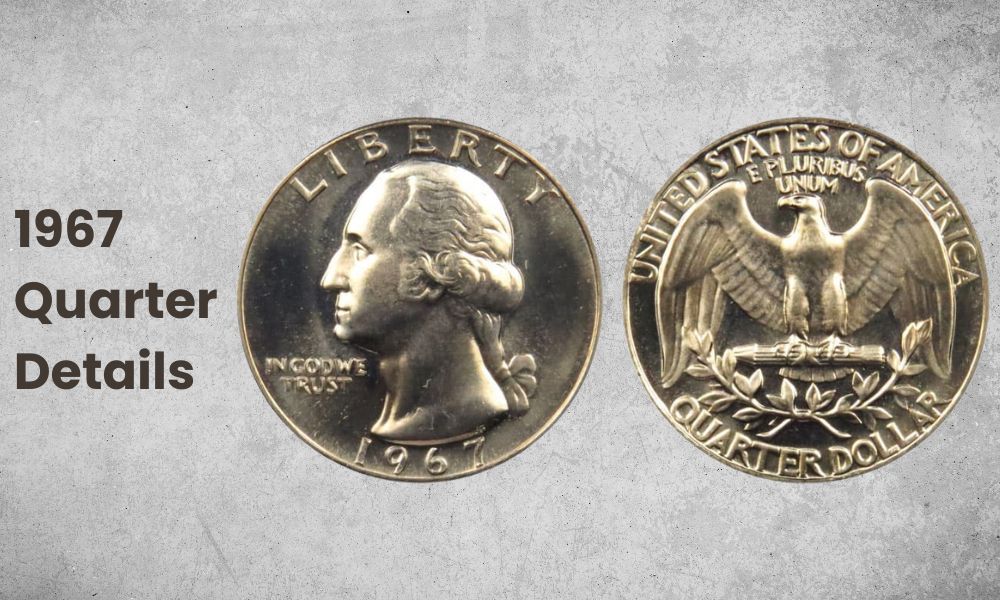
- Category: Washington Quarters
- Mints: Philadelphia, San Francisco, and others not disclosed
- Total mintage: 1,524,031,848
- Obverse designer: John Flanagan
- Reverse designer: John Flanagan
- Edge: Reeded
- Diameter: 24.3 mm
- Content: 75% copper and 25% nickel over copper core
- Weight: 5.67 grams
The 200th anniversary of George Washington’s birth saw many festivities to mark the occasion. From declamation and essay-writing contests in schools to private events to honor Washington’s life., celebrations abounded in 1932.
The U.S. Treasury wanted in on the festivities, too. So, they sought to put the head of George Washington on the quarter that year. Beginning in 1932, the quarter dollar coins’ obverse saw the side profile of the first president of the United States of America.
By 1967, the composition of the Washington quarter was already quite different from how it was 35 years prior. From silver, it was changed to a copper-nickel-clad copper coin. However, the design, originally crafted by John Flanagan, stayed the same.
On the obverse, we see George Washington’s head facing left with a stern look and a simple braid. On the upper rim is the word “LIBERTY,” and on the bottom, the year 1967. Right underneath Washington’s chin is the phrase “In God We Trust” in capital letters.
The coin’s reverse is a little more creative. It shows the American eagle with its wings spread wide. It sits on a bundle of arrows attached to two olive branches. It seems to symbolize both peace and power.
The reverse’s upper rim has the words “United States of America,” along with “E Pluribus Unum” in a smaller font underneath it. The bottom rim shows the denomination “Quarter Dollar.”
No Mint Marks in 1967
What’s unique about the 1967 quarters is that none have mint marks. The Philadelphia Mint—a Mint known not to put any mint marks on their coins—is known to have produced many of the coins. Other mints also seemed to make some, but they were never struck with their usual mint mark.
This is because the price of silver was shooting up in the 1960s. Many Americans hoarded the quarters each year and melted them down for more money, resulting in a shortage of coins.
So, the U.S. Mint decided to remove mint marks on the quarter from 1965-1967 in an attempt to dispel speculation on the value of a quarter depending on where they were minted.
San Francisco is known to produce some of the 1967 quarters, but only coins with a special satin finish. These coins were not made for circulation and were sold to collectors in special, mint-state sets, similar to proof coins.
Also Read: Top 15 Most Valuable Quarters In Circulation
1967 Quarter Value Chart
| 1967 Quarter with No Mint Mark (P) Value Chart | |||||
| Extremely Fine | AU58 About Uncirculated | MS62 Uncirculated | MS65 Gem Uncirculated | MS67 Superb Gem Uncirculated | MS68 Superb Gem Uncirculated |
| $0.30 | $0.75 | $3.50 | $10 | $150 | $6,250 |
1967 Quarter Value and Variety Guides
1967 Quarter Value for No Mint Mark
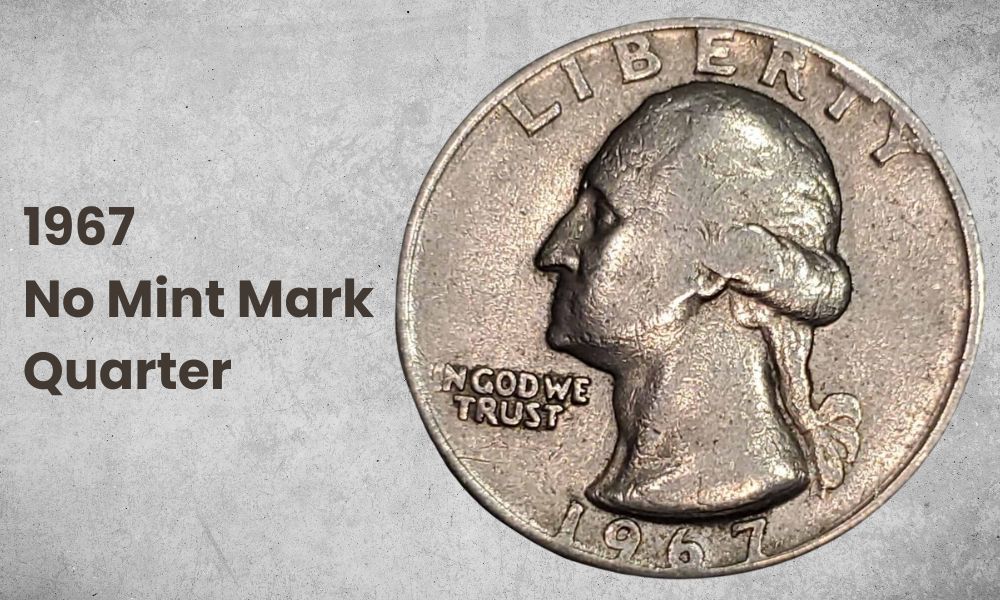
- Type: Washington Quarters
- Edge: Reeded
- Mint mark: No mint mark
- Year of minting: 1967
- Face value: $0.25
- $ price: $0.30 to $6,250
- Quantity produced: 1,524,031,848
- Designer: John Flanagan
There is only one variety for the 1967 quarter—the one with no mint mark. Over 1.5 billion coins of this type were minted in 1967.
While one can presume that many of these were struck in the Philadelphia Mint (which never strikes coins with mint marks anyway), all 1967 quarters were struck with no letter mark, regardless of where they came from.
In Circulated Conditions
Even in poor to average circulated condition, a 1967 quarter will have a value of at least $0.30. This goes all the way to extremely fine condition.
In about uncirculated condition, the value shoots up. An AU50 can be sold today for around $0.40. Meanwhile, an AU58—the highest about uncirculated grade before a coin is designated a mint-state grading—can be valued at $0.75.
Of course, this value increases when the coin has rarities, like mint errors. For example, an AU58 coin once sold for $69 because it had been struck on a ten-cent planchet. Other mint errors you might find in circulated coins include curved clips and doubling.
In Mint-Sate, Uncirculated Conditions
The 1967 Washington quarters are usually found in collections in mint-state condition, specifically in grades MS65 to MS67. That said, there aren’t too many of them, making them rare and valuable.
At MS60 to MS65, the 1967 quarter can be valued anywhere between $1.50 to $10. The price gets way higher after the MS66 mark, which can get you about $25 when sold. At MS67, this price increases to $150; at MS68, it gets to a whopping amount of $6,250.
However, these prices aren’t always the standard. If you’re lucky, a very high-grade coin can be auctioned off for way higher than its set value. For example, an MS67+ coin is valued at $675. But a coin with this grade was sold for $5,170 back in 2016 even with no mint errors or rarities.
Also Read: Top 16 Most Valuable Modern Quarters Worth Money
History of the 1967 Quarter Value
The Great Depression of the 1930s was tough for many Americans. However, it did not kill the nation’s excitement for the 200th birth anniversary of George Washington in 1932. One of the things the country did that year to commemorate the occasion was to put Washington on the quarter.
The U.S. Treasury hosted a massive competition for coin designs modeled after Jean Antoine Houdon’s bust of George Washington. About a hundred entries came rolling in. But the one design that stood out to the Commission was that of Laura Gardin Fraser.
Fraser took a more artistic approach to her design, which wowed the Commission. However, the Treasury Secretary, Andrew Mellon, was unhappy with the design. Although the Commission pleaded with him to push through with the mintage with Fraser’s design, he refused.
Instead, Mellon asked medalist John Flanagan to work on the design instead. Some say it was because he had a bias against women, but we’ll never know for sure. This move resulted in the straightforward, simple Washington quarter design we know today.
The Washington quarters are very popular among coin collectors in the modern age. They are especially loved and sought after in mint-state condition.
Also Read: 10+ Rarest State Quarter Errors Lists (Worth Much Money!!!)
1967 Quarter Value Grading
It can be tricky grading a 1967 Washington quarter. Only coin-grading experts can pinpoint the exact grade of a coin.
For some novice coin collectors, the only way to assess the coin is to compare it to photos in grading guides. Here’s a quick guide to try and see which coin grade your 1967 quarter falls under:
- Good (circulated): You can tell the coin has been in circulation because of its heavy wear. However, the design elements are still intact. Some areas with supposedly intricate lines—like Washington’s hair and facial features or the Eagle’s wing feathers—may look smooth and flat.
- Extremely fine (circulated): Some wear is visible on the coin, but it still has some luster. The lines of the design are still bold and sharp. If there is any wear, it’s likely only on the coin’s highest points, like Washington’s hair and the tips of the eagle’s wings.
- AU55 (about uncirculated): Very minor wear on the coin, but it’s still noticeable to the human eye. Its luster is likely still complete.
- MS67 (mint-state, uncirculated): A near-perfect coin that looks like it has never been touched. Luster is very bright and shiny. There might be one or two contact marks, but nothing that’s immediately noticeable without a microscope or magnifying glass.
Need more help figuring out your 1967 Washington quarter’s grade? Let this video be your guide:
1967 Quarter Value Errors
Many mint errors can be found in the 1967 issue of the Washington quarter. What’s funny is that these errors don’t just occur in one or two coins. Many of these errors have been found in handfuls of quarters. Check them out:
1. 1967 Quarter Missing Obverse Clad Layer Error
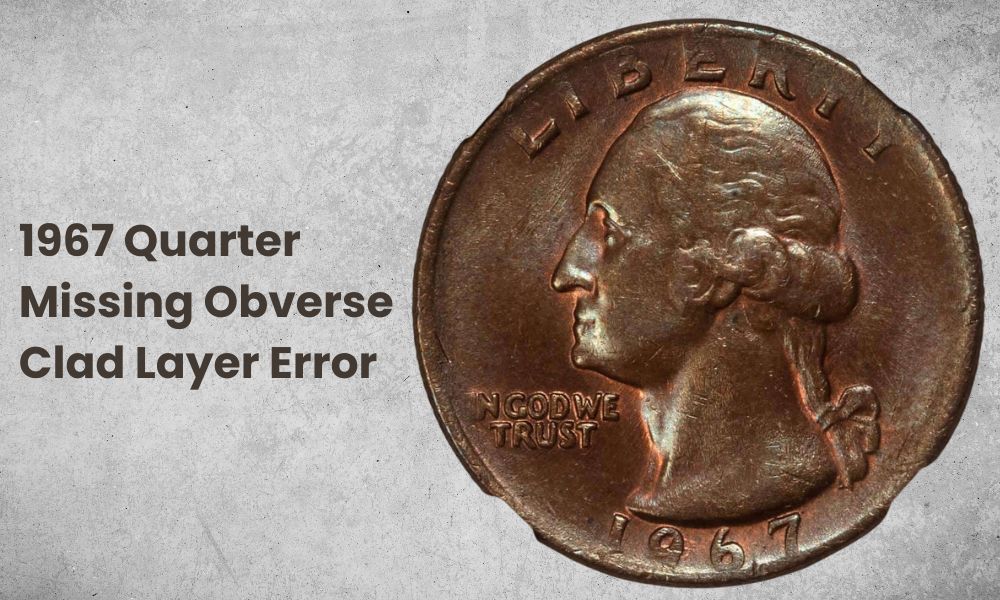
One of the most intriguing errors to be found in the 1967 Washington quarter is the missing clad layer on the obverse of the coin.
This error occurs when the coin’s reverse has a full copper-nickel clad layer on, but the obverse does not. Instead, it has an exposed copper core with no shine and luster.
A missing clad layer on an obverse has been found on an MS64 1967 Washington quarter. It ended up selling for around $80.
2. 1967 Quarter Curved Clip Errors
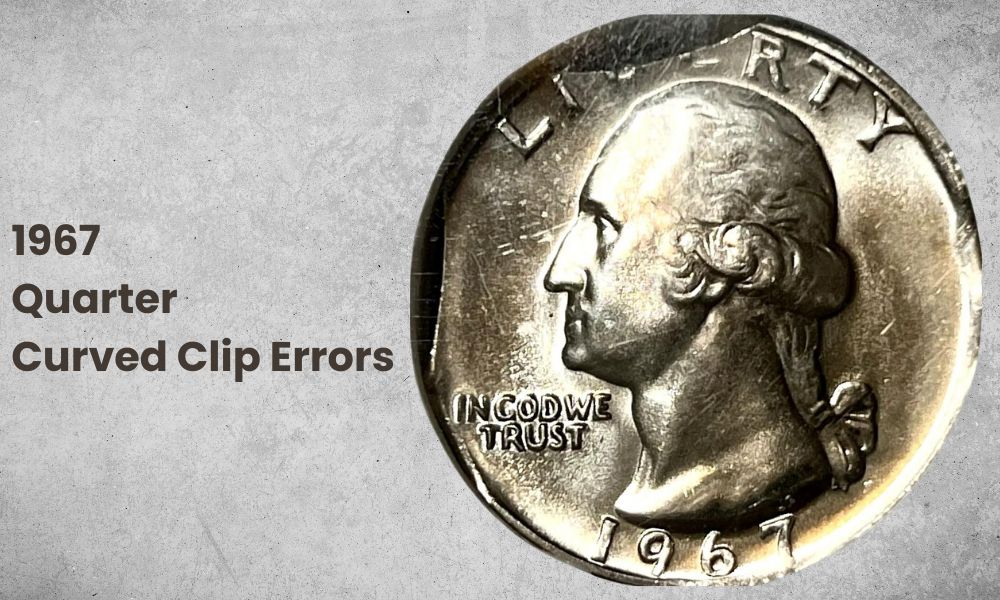
A curved clip is an error that manifests in a concave deficit on a coin’s metal. It happens when a punching die at the Mint punches a hole a second time into a planchet already cut into shape. As a result, there’s a “chip” in the final coin.
It’s also possible for a coin to have multiple curved clips at once. In 2015, an AU55 coin was found to have three different curved clips on it. It ended up selling for $44, even if the value of a coin in this grade is only $0.50.
And when a coin has a high grade and other errors in conjunction with a curved clip, the value is even greater. An MS65 coin with a curved clip and a partial collar error, for example, once sold for $130.
3. 1967 Quarter Value Struck on Wrong Planchets
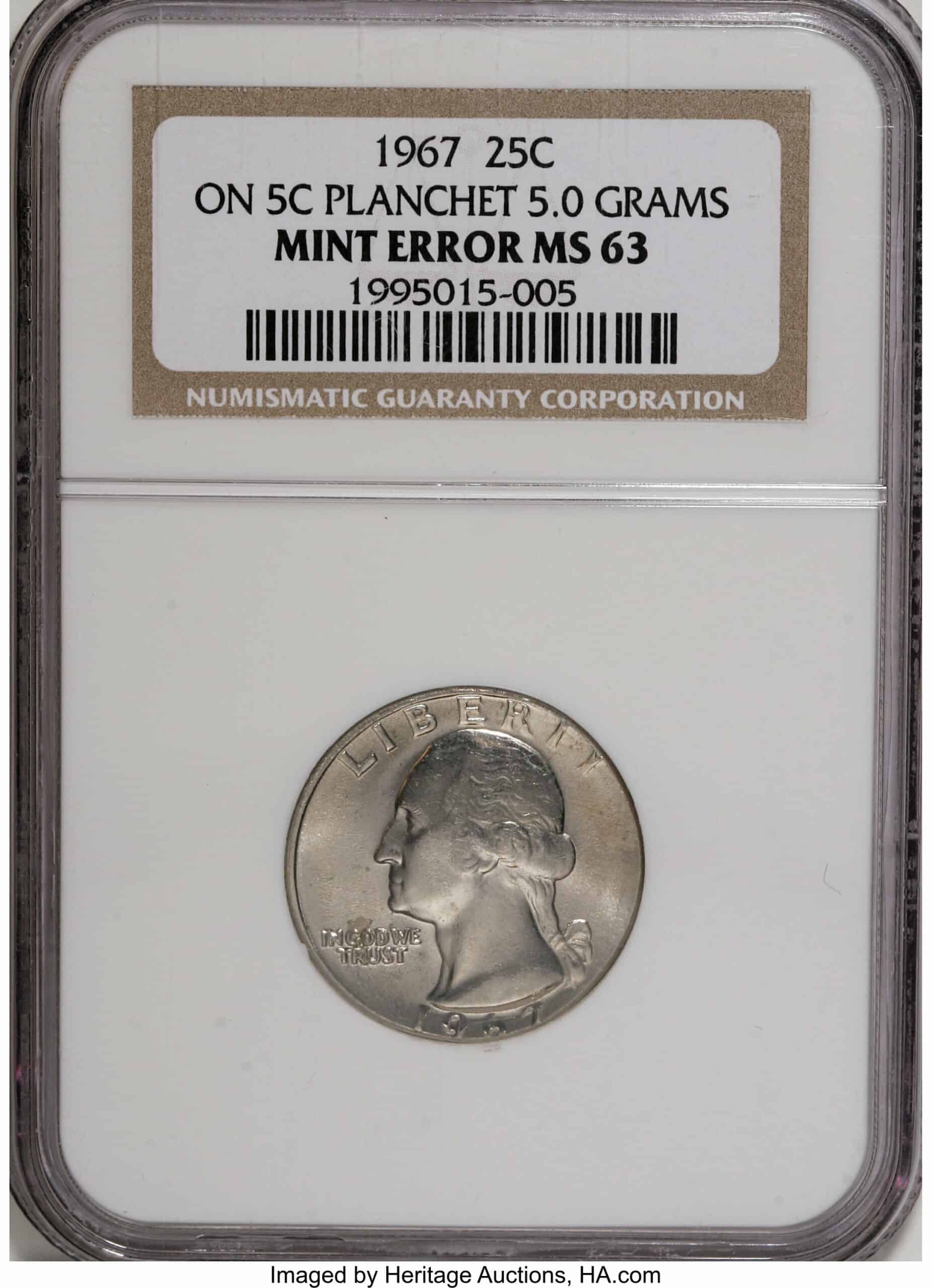
Sometimes, a coin will be mistakenly struck on the wrong planchet meant for another denomination. It happens when the wrong planchet is fed into the die, presumably because the Mint was just producing another type of coin sometime earlier.
You might think this error is rare, but it has happened in many 1967 Washington quarters. One such example is an AU58 coin that was accidentally struck on a five-cent planchet, which is much smaller than a quarter planchet.
As a result, the word “LIBERTY” at the top of the obverse is cut off and illegible. This coin was sold for $207, even if the value of an AU58 coin today is at around $0.75 only.
Another interesting example of a 1967 Washington quarter struck on the wrong planchet is this MS65 coin minted on a one-cent planchet.
The portrait of Washington and the American eagle are complete, but none of the words around the coin’s rim can be seen. This coin ended up selling in 2013 for over $2,100.
1967 Quarter FAQs
How can you tell if a quarter is rare?
You’ll know that your 1967 quarter is rare if it’s either got a mint error on it or is graded as a mint-state coin.
Mint errors make a coin look unique and one-of-a-kind, which raises its value. The same goes for quarters that are designated an uncirculated grade of MS60 and above. Quarters in grades MS67 and higher are especially valuable.
Is a 1967 quarter real silver?
No, the 1967 quarter has no silver in its composition. From 1932 to 1964, the quarter used to be made of 90% silver. But in 1965, the composition was switched to copper-nickel-clad copper to save on the U.S. Treasury’s stock of silver.
What years of quarters are worth money?
Quarters minted before 1965 are very valuable because they were made with 90% silver. Today, their value will be tied to the melt value of silver, which is usually high compared to a quarter’s $0.25 face value.
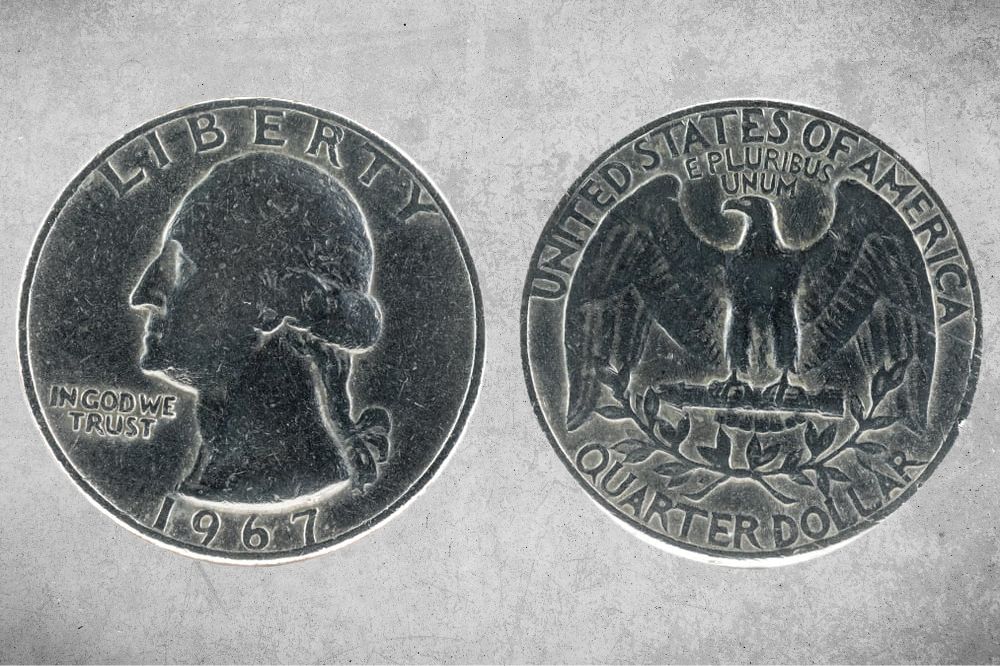
I want to Thank you I love this site, it explains all you need to know about coins it’s really a great site.
Thank you for your knowledge, great sight. This has been a new and surprising experience for me thank you.
Great experience